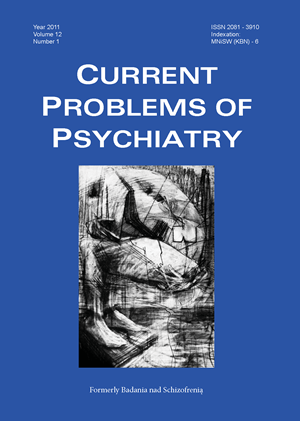Taksonomia deskryptorów osobowych w języku polskim: studium psycholeksykalne
Słowa kluczowe:
podejście leksykalne, deskryptory dyspozycji, polskie przymiotniki, Wielka PiątkaAbstrakt
This paper describes the development of a comprehensive taxonomy of person-descriptive terms in Polish, organized in two studies. In the first study, two judges searched through The Universal Dictionary of Polish Language (100 000 terms) for person-descriptive terms. In the second study, 4555 person-descriptive adjectives were classified by nine judges into 13 different subcategories of the psycho-lexical classification system. Our studies provide comprehensive and representative lists of Polish adjectives for describing personality traits, which may be used in establishing the structure of human personality descriptions by means of self-rating or peerrating surveys of a full age range Polish population of respondents.
Bibliografia
1. Galton F. Measurement of character. Fortnightly Review 1884; 36: 179-185.
2. Cattell RB. Confirmation and clarification of primary personality factors. Psychometria 1947; 12(3): 197-220.
3. Fiske D.W. Consistency of the factorial structures of personality ratings from different sources. J Abnorm Soc Psychol 1949; 44(3): 329-344.
4. Goldberg LR, Digman JM. Revealing structure in the data: Principles of exploratory factor analysis. In: Strack S, Lorr M eds., Differentiating normal and abnormal personality. New York; Springer: 1994, pp. 216-242.
5. Norman WT. Toward an adequate taxonomy of personality attributes: Replicated factor structure in peer nomination personality ratings. J Abnorm Soc Psychol 1963; 66(6): 574-583.
6. Tupes EC. Recurrent personality factors based on trait ratings by peers: their validity for prediction and evaluation and their measurement for selection purposes. Research Rep 1960. www.icodap.org/papers/onr/onr-acr-60-1960-229-234.pdf.
7. Passini FT, Norman WT. A universal conception of personality structure? J. Pers Soc Psychol 1966; 4(1): 44-49.
8. Goldberg L.R. An Alternative ‘Description of personality’: The Big-Five factor structure. J Pers Soc Psychol 1990; 59(6): 1216-1229.
9. Saucier G, Goldberg LR. The structure of personality attributes. In: Barrick M, Ryan AM eds., Personality and work. New York; Jossey- Bass-Pfeiffer: 2003, pp. 1-29.
10. John O, Angleitner A, Ostendorf F. The lexical approach to personality: a historical review of trait taxonomic research. Eur J Pers 1988; 2(3): 171-203.
11. Norman WT. 2800 Personality Trait Descriptors: Normative Operating Characteristics for a University Population. Department of Psychology, University of Michigan; Ann Arbor Research Rep. Nr 08310-1-T, 1967.
12. Szarota P. Polska lista przymiotnikowa (PLP): narzędzie do diagnozy pięciu wielkich czynników osobowości. Stud Psychol 1995; 23(1-2): 227-255.
13. Szarota P, Ashton MC, Lee K. Taxonomy and structure of the Polish Personality Lexicon. Eur J Pers 2007; 21(6): 823-853.
14. Skorupka RA., Auderska H, Łempicka Z. Mały słownik języka polskiego. Warszawa; Wiedza Powszechna: 1968.
15. Dubisz S ed. Uniwersalny słownik języka polskiego. Warszawa; PWN: 2008.
16. Angleitner A., Ostendorf F., John O.P. Towards a taxonomy of personality descriptors in German: A psycho-lexical study. Eur. J. Pers., 1990; 4(2): 89-118.
17. Szirmak Z, De Raad B. Taxonomy and structure of Hungarian personality traits. Eur J Pers 1994; 8(2): 95-117.
18. Schmitt N. Uses and Abuses of Coefficient Alpha. Psychol Assessment 1996; 8(4): 350-353.
19. Mlacic B, Ostendorf, F. Taxonomy and structure of Croatian personality- descriptive adjectives. Eur J Pers 2005; 19(2): 117-152.
20. Ashton MC, Lee K, Goldberg LR. A hierarchical analysis of 1,710 English personality-descriptive adjectives. J Pers Soc Psychol 2004; 87(5): 707-721.
21. Goldberg LR. From ace to zombie: Some explorations in the language of personality. In: Spielberger CD, Butcher JN eds., Advances in personality assessment. Hillsdale, NJ; Erlbaum: 1982, Vol. 1, pp. 203-234.
22. Shmelyov AG, Pokhilko VI. A taxonomy-oriented study of Russian personality-trait names. Eur J Pers, 1993; 7(1): 1-17.
23. Triandis HC, Suh EM. Cultural influences on personality. Annu Rev Psychol 2002; 53(1): 133-160.
24. Ashton MC, Lee K, Perugini M, Szarota P, de Vries RE, Di Blas L, Boies K, De Raad B. A six-factor structure of personalitydescriptive adjectives: Solutions from psycholexical studies in seven languages. J Pers Soc Psychol 2004; 86(2): 356-366.
25. Block J. A contrarian view of the five-factor approach to personality description. Psychol Bull 1995; 117(2): 187-229.
26. Block J. The five-factor framing of personality and beyond: Some ruminations. Psychol Inquiry 2010; 21(1): 2-25.
27. Cattell RB. The fallacy of five factors in the personality sphere. Psychologist 1995; 8(5): 207-208.
28. McAdams DP. The five-factor model in personality: A critical appraisal. J Pers 1992; 60(2): 329-361.
29. Mischel W, Shoda Y. Personality psychology has two goals: Must it be two fields? Psychol Inquiry 1994; 5(2): 156-158.
Pobrania
Opublikowane
Numer
Dział
Licencja
Prawa autorskie (c) 2011 Autorzy

Praca jest udostępniana na licencji Creative Commons Attribution-NonCommercial-NoDerivatives 3.0 Unported License.


